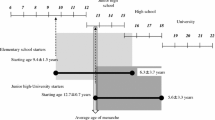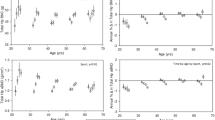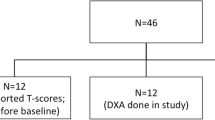Abstract
This longitudinal study examined whether bone mineral density (BMD) of the lumbar spine and the proximal femur is maintained in pre-, peri-, and postmenopausal women by regular exerise. BMD was measured using dualenergy X-ray absorptiometry (DXA). Twenty-six Japanese women (mean age 47.8 years) were followed 4–5 years. Twenty-two subjects from volleyball or jogging clubs had participated in the same exercise for more than 5 years at the initial BMD measurement. Longitudinally, for these 22 athletes, the rate of change per year in BMD of the lumbar spine was -0.17% in the premenopause group and -2.60% in the perimenopause group. In the proximal femur of the athletes, BMD increased (rate of increase per year 1.80%) in the premenopause group, but decreased (rate of decrease per year 1.07%) in the perimenopause group. In the premenopause group, BMD of the proximal femur increased in all athletes. However, in the proximal femur, the nonexercise group showed a 0.31% decrease, a significant difference (P <0.05) compared with the athletes. These findings suggest that women can achieve continuous gains in bone mass in the proximal femur before menopause by regular intense exercise. However, continued high-level physical activity in the perimenopausal women was not able to prevent bone loss.
Similar content being viewed by others
References
Riggs BL, Wahner HW, Melton LJ III, Richelson LS, Judd HL, Offord KP (1986) Rates of bone loss in the appendicular and axial skeletons of women: evidence of substantial vertebral bone loss before menopause. J Clin Invest 77:1487–1491
Rodin A, Murby B, Smith MA, Caleffi M, Fentiman I, Chapman MG, Fogelman I (1990) Premenopausal bone loss in the lumbar spine and neck of femur: a study of 225 Caucasian women. Bone 11:1–5
Soda M, Mizunuma H, Honjo S, Okano H, Ibuki Y, Igarashi M (1993) Pre- and postmenopausal bone mineral density of the spine and proximal femur in Japanese women assessed by dual-energy X-ray absorptiometry: a cross-sectional study. J Bone Miner Res 8:183–189
Lu PW, Briody JN, Ogle GD, Morley K, Humphries IRJ, Allen J, Howman-Giles R, Silence D, Cowell CT (1994) Bone mineral density of total body, spine, and femoral neck in children and young adults: a cross-sectional and longitudinal study. J Bone Miner Res 9:1451–1458
Elders PJM, Lips P, Netelebos JC, van Ginkel FC, Khoe E, van der Vijgh WJF, van der Stelt PF (1994) Long-term effect of calcium supplementation on bone loss in perimenopausal women. J Bone Miner Res 9:963–970
Grove KA, Londeree BR (1992) Bone density in postmenopausal women: high impact vs low impact exercise. Med Sci Sports Exerc 24:1190–1194
Hatori M, Hasegawa A, Adachi H, Shinozaki A, Hayashi R, Okano H, Mizunuma H, Murata K (1993) The effects of walking at the anaerobic threshold level on vertebral bone loss in postmenopausal women. Calcif Tissue Int 52:411–414
Hyakutake S, Goto S, Yamagata M, Moriya H (1994) Relationship between bone mineral density of the proximal femur and lumbar spine and quadriceps and hamstrings torque in healthy Japanese subjects. Calcif Tissue Int 55:223–229
Zar IH (1984) Biostatistical analysis, 2nd ed. Prentice-Hall Inc, New Jersey
Gleeson PB, Protas EJ, LeBlanc AD, Schneider VS, Evans HJ (1990) Effects of weight lifting on bone mineral density in premenopausal women. J Bone Miner Res 5:153–158
Rockwell JC, Sorensen AM, Baker S, Leahey D, Stock JL, Michaels J, Baran DT (1990) Weight training decreases vertebral bone density in premenopausal women: a prospective study. J Clin Endocrinol Metab 71:988–993
Goto S, Hyakutake S, Shigeta H (1995) The Third Osteoporosis Study Meeting Consensus Development Symposium strategy against osteoporosis: prophylaxis and treatment: a long-term longitudinal study of bone mineral density in assessing the prophylactic effects of athletic activity. Osteoporosis Japan 3:110–118 (in Japanese)
Cavanaugh DJ, Cann CE (1988) Brisk walking does not stop bone loss in postmenopausal women. Bone 9:201–204
Sinaki M, Wahner HW, Offord KP, Hodgson SF (1989) Efficacy of nonloading exercises in prevention of vertebral bone loss in postmenopausal women: a controlled trial. Mayo Clin Proc 64:762–769
Welten DC, Kemper HCG, Post GB, van Mechelen W, Twisk J, Lips P, Teule GJ (1994) Weight-bearing activity during youth is a more important factor for peak bone mass than calcium intake. J Bone Miner Res 9:1089–1096
Author information
Authors and Affiliations
Rights and permissions
About this article
Cite this article
Goto, S., Shigeta, H., Hyakutake, S. et al. Comparison between menopause-related changes in bone mineral density of the lumbar spine and the proximal femur in Japanese female athletes: A long-term longitudinal study using dual-energy X-ray absorptiometry. Calcif Tissue Int 59, 461–465 (1996). https://doi.org/10.1007/BF00369211
Received:
Accepted:
Issue Date:
DOI: https://doi.org/10.1007/BF00369211




